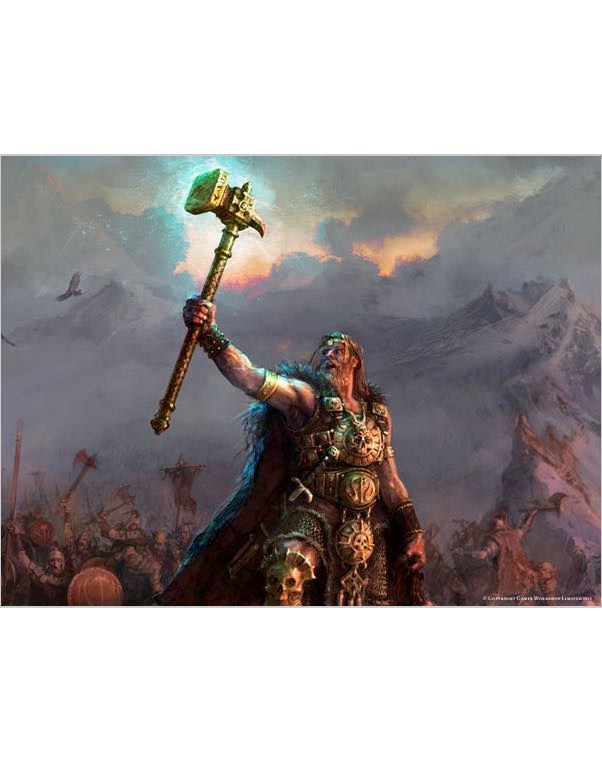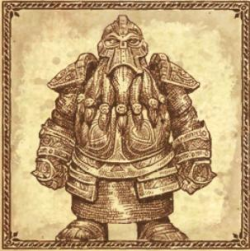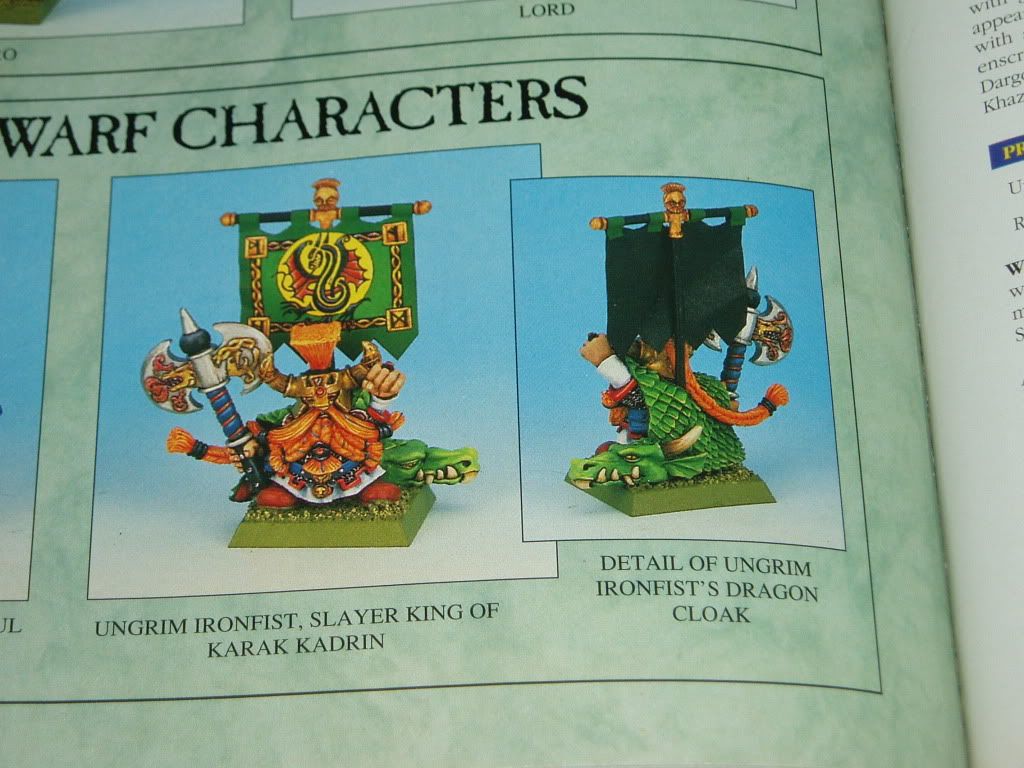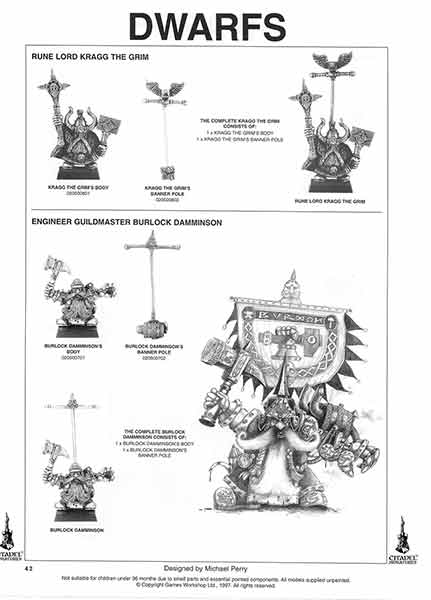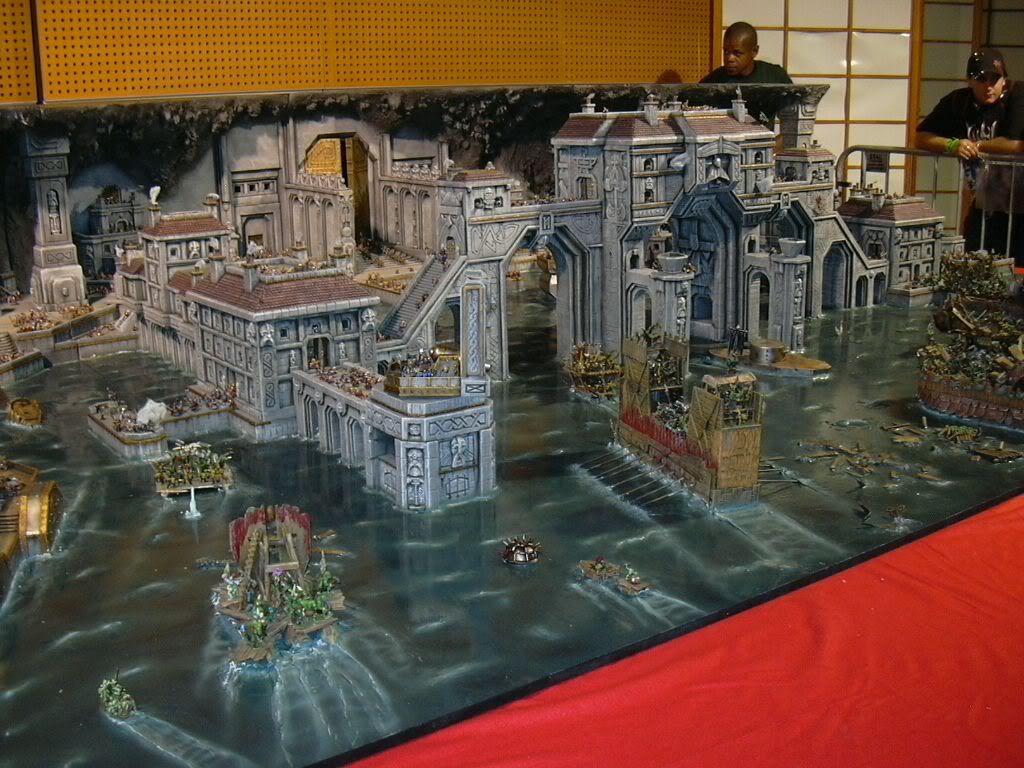The Dwarf Army List
So, for anyone that hasn't been paying attention, Warhammer Fantasy is a game where you can basically re-play the Battle of Five Armies from
The Hobbit or the Siege of Helm's Deep from
The Lord of the Rings. It arose directly out of miniatures wargaming, which up until that point was dominated by boxes with set-piece battles, often involving moving little cardboard chits representing units around a provided map as you worked you way through some historical (or more rarely) fantasy scenario. It was all jolly good fun and eventually led to Dungeons & Dragons.
 Among other things.
Among other things.
Warhammer basically added two innovations to this: a range of
collectible miniature models to represent your units, and the ability to build your own armies. All players involved would buy (and assemble, and paint...well, if you're lucky) the models they wanted from a particular army or armies. Each model had a given point value, based on the options for that model in it's side's Army List.
For example, the general unit of the 1993 Dwarf Army List was the Dwarf Warrior (11 points per model); for an additional (+2) points per model they could be equipped with great weapons, or for (+1) points per model they could be equipped with spears. Any unit of Dwarf Warriors could come equipped with a magic standard at the cost indicated for the item.
So, when you and your frenemies wanted to play, you would pick a point total - say, 500 or 1,000 points, with truly enormous battles being 3,000 points - and then each side would bring models (with options) totaling up to that amount (it's hard to do 1,000 points exactly). If you do the math on your fingers, then you see that for a 500 point battle you could easily have 100 models on the board (counting both sides) - and Dwarfs are rather expensive; Hobgoblins in Chaos Dwarf armies might have been shit, but they were
2 points each. So you can rather see why Orcs & Goblin armies were often considered "the Green Tide" (and, as well, why few people in casual play came in with fully-painted armies).
The "typical" army stabilized around 2,000 points at least by 6th edition, if not sooner. Now, that's a
sizable investment. We're talking about 100 models if you're going for just regular Dwarfs out for a picnic and a bit of bloodshed. A typical "regiment" box comes with 16 plastic sprue models, so you're probably looking at about six of those...at £20 a box...before counting glue and paint. That's going on at least £150 worth of plastic, is what I'm getting at (oh, and £15 or so for the army book), and a couple days of your life painting the things. It's not a hobby for the faint-hearted, is what I'm getting at...and the
cool shit costs more.*
*
But you never start buying the cool shit. You always start off buying crap rank-and-file models, so that you can hone your painting chops. Well is it said, the last 1,000 points you paint is always better than the first 1,000 points you paint. My brother and I actually had a lovely bonding experience over a matter of weeks sitting at a card table outside the garage (please paint in a well-ventilated area) losing skin to superglue and having a fun time with the model paints.
Of course, you rarely have quite so many models on the board; war machines, heroes, generals, and the like are expensive, and beyond that there are general restrictions as to how many of a given type of unit or number of heroes you could have in play, often based on the total point value of the army. These restrictions were tightened up in subsequent editions to limit the Herohammer nonsense, often requiring more of the basic rank-and-file troops before you could buy units of the Dwarf special forces.
But let's look at your basic Dwarf units. Your average Dwarf has relatively low movement (3" movement, -1" on flee and pursuit), but better-than-average Weapon Skill (4) and Toughness (4), decent armor (save on 5+ or 6+) and nigh-unbreakable Leadership (9). In a melee fight, they will grind most other races rank-and-file, but are often outnumbered and relatively less mobile. On the other hand, they will very rarely flee if handled right.
All Dwarfs
Hate Orcs and Goblins, and bear grudges against Elves (which only really comes into play in mixed/allied armies).

In 1993, your basic regiments were Dwarf Warriors (11 points/model), Dwarf Crossbowmen (13/m), and Dwarf Thunderers (13/m), and you could have any number of regiments of these units in your army. Crossbowmen and Thunderers provided ranged weapons, which were relatively good - even if the Dwarf Bow Skill is only 3 - but lacks the range of the proper archery of other armies. So yes, Wood Elves can and did sit outside of range of the Dwarfs and pepper them with arrows, at least until the cannons got lined up and the range right... A lot of dwarf strategies emphasize "let the enemy come to us" (often coupled with "as we line up the artillery"), because they basically have no cavalry, move slowly, and are outnumbered almost by definition.
 I own a tin of these. The ones with the arrow are scatter dice.
I own a tin of these. The ones with the arrow are scatter dice.
You may have one regiment of Dwarf Miners (13/m). The 1993 book for some reason leaves out their special ability, so I'll talk about that later.
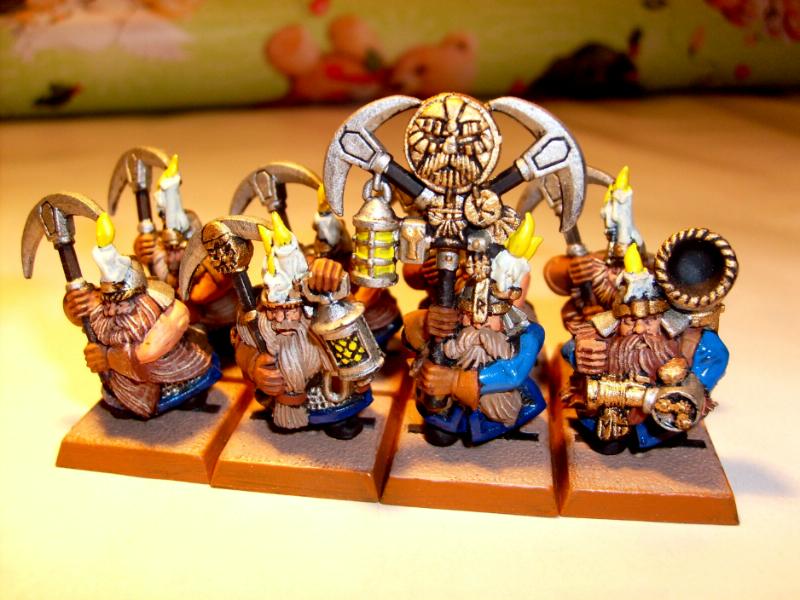
You may have one regiment of Long Beards (15/m). Dwarfs quite literally empty out the retirement homes when they go to battle, under the thought process that the guys that have survived the longest (and have the beards to show for it) are righteous badasses. Sort of like fielding an entire regiment of WWII veterans
that never got weaker. Mechanically they count as "elite" troops because they have slightly better stats all around.

You may have one regiment of Hammerers (15/m). Mechanically they're identical to Longbeards, but for +2/m you can equip them with great big fucking two-headed hammers. That was important in 4th edition.
 Really, the standard-bearer could just hold a colossal fucking hammer and it would do wonders for Dwarf morale.
Really, the standard-bearer could just hold a colossal fucking hammer and it would do wonders for Dwarf morale.
You can have one regiment of Iron Breakers (20/m). They have the same stats as Long beards, but in 1993 every one of them gets a bonus Rune of Stone thrown in, which means their armour save is 3 or higher on a d6, and that goes for the unit champion as well. That basically means these guys are the anvil that the enemy armies are crushed against.

Slayers are wonderfully broken in 1993, and here I'm going to break from above and delve into the fluff a little. The Cult of Slayers are dwarfs driven mad by grief and dishonor; the only way they can redeem themselves is by dying in battle, preferably by taking out the biggest bastard they can first. So they were no armour, wield big fucking weapons, get lots of tattoos, piercings, and stuff, and die and cut their hair into gigantic mohawks. They're fanatics who will only go to the halls of their ancestors through your bloody entrails.
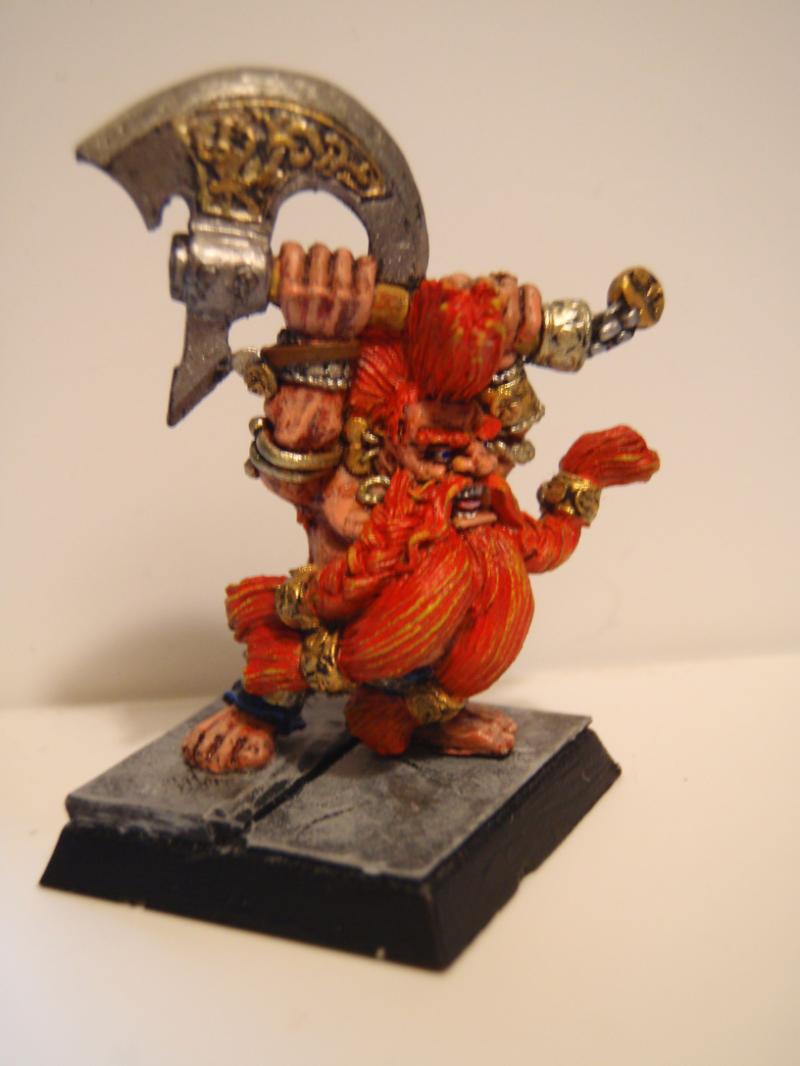
Dwarf Slayers owe their continued popularity to the Gotrek & Felix novels by William King, where Gotrek goes from your average Trollslayer to a virtual dwarf demigod, slaying Dragons, Daemons, Giants, and more goblins and skaven than you can shake a gore-stained starmetal axe at. He's a ridiculous character and I treasure my set of the series; the books after King are shit.
Anyway.
You can have up to N - 1 regiments of Slayers in your Dwarf army, where N = your number of other regiments. They cost 11 points each, have average stats, and no armour, so they all die fast - but they get a Strength bonus when facing high-toughness monsters and can't be broken (they'd much rather die in battle). On the other hand, you can arm them with several different weapons and you can field as many Slayer champions as you want - Dragon Slayers, Daemon Slayers, or Giant Slayers. These guys are hideously expensive, but get more attacks and can be equipped with magic weapons for
more points. So these guys were straight Herohammer beardy madness.
 TODAY IS A GOOD DAY TO DIE!
TODAY IS A GOOD DAY TO DIE!
Characters in Warhammer Fantasy, of every edition, tend to be overpriced and ridiculous, but they are traditional. The basic idea is that you can have a command group for each regiment (Champion, Standard Bearer, and Musician), and in addition to this you have an army General, a Battle Standard, Heroes, etc. These are the characters you can typically load down with magic items, and even without that they have army-wide benefits, like letting all troops within 12" re-roll to rally checks if fleeing and whatnot.*
*
Warhammer does not, in general, favor the idea that all units on both sides of a battle will fight until every squire and standard-bearer is dead. Rather, at a certain point if enough damage is done, you roll the dice and leg it for the edge of the table. For Dwarfs, this is rarely an issue (Leadership 9), but for Orcs & Goblins or Skaven (Leadership 2-3), it means that they really do need generals, standard bearers, and massive superior numbers just to avoid running away at the first opportunity. In Warhammer 40k, they get to have commissars who shoot units to improve the morale of other units, but Warhammer Fantasy tactics haven't quite gotten there yet.
Dwarfs have basic General (160 points), Standard Bearer (98), Heroes (104), and Champions (48), plus Slayer champions: Giant (63), Dragon (136), and Daemon (210). Most armies have sorcerers, but Dwarfs instead can have a Runesmith (78), Master Runesmith (187), or Rune Lord (306). Unlike sorcerers, the main benefit of Runesmiths is that you can equip them with up to
three rune weapons, and have substantially better stats than even the Dwarf Special Forces. This basically makes them the equivalent of a Thug or Supercombatant chassis in Dominions III/IV; you load them up with magic weapons, armors, and talismans and set them out to destroy the enemy...or at least negate the enemy sorcerers.
Of course, for an extra 200 points a Runesmith can have an Anvil of Doom.
 Later editions were less mobile.
Later editions were less mobile.
Every version of the Anvil of Doom has had different stats, mainly because the magic system changes subtly or unsubtly between editions. In 4th edition, for example, the magic system involved a special deck of cards dealt out during the Magic Phase; later editions moved to power dice. Anyway, in 1993 the Anvil of Doom could be charged up by storing magic cards and then a Runesmith could use it like an artillery piece to fire bolts of magic lightning across the battlefield. Like cannons, the anvil could occasionally explode.
Speaking of artillery, the Dwarfs have quite a variety available. They have two sizes of Stone Thrower (small and Big - go ahead and supersize it), a bolt thrower, a flame cannon...
 At last, an excuse to use the flame template
At last, an excuse to use the flame template.
...an organ gun, a dwarf cannon, and of course a Gyrocopter.
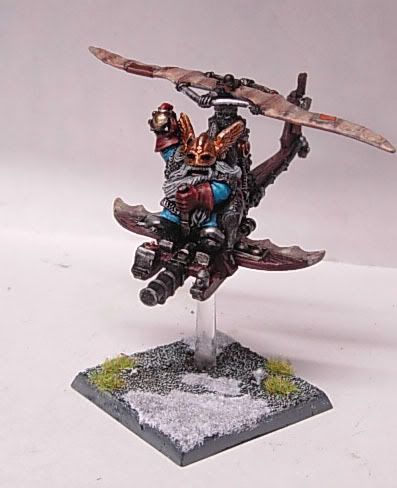
I seriously think that the only reason the Dwarfs have a gyrocopter is because every army in 4th edition had a flying unit, and somebody felt the Dwarfs needed something to counter the dragons and pegasus knights. I don't care. I love it.
Unlike in later editions, the Dwarfs had no limit to how many artillery pieces they could field. So you really could have a General, a regiment of Thunderers and a bunch of cannon up on a hill and try to bombard the enemy to death. The differences between the artillery units is mostly academic, involving various trade-offs between range, penetration, and template. You literally picked a direction, guesstimated the range, then rolled the dice to see what exploded and/or who/what you hit.
And that's the 1993 army list. It's not really standardized, the layout of the information is terrible and interspersed with short fiction and sample dwarf banners and shit, but you can sort of see the outlines of what they were going for, and the whole section saw a lot of development and refinement in the 2000 army book (as "The Dwarf Throng" -
throng being Khazalid for army). Each individual unit gets its own page (or two) of fluff and special rules, followed a condensed army list with individual points.
The basic dwarfiness of the army and most of the unit names remain intact, but the mechanics were nerfed to both give more choices and less overpowered Herohammer foolishness. So the Anvil of Doom, for example, basically lets Dwarf Runesmiths to spend power dice on casting runes (Water, Air, Fire, or Earth) like other race's sorcerers cast spells.*
*
Basic mechanic: pick the spell you want to attempt, it has a casting value you have to meet or beat to cast it successfully. You get X dice during your Magic Phase and can spend (roll) them to try and add up to the Casting Value. Dwarfs with an Anvil get D6+2 dice, and the casting values range from 6+ (water, bogs a unit down), 7+ (air, lightning bolt), 8+ (fire, magic missile), to 9+ (earth, earthquake).
We won't get into Dispel dice, but Dwarfs get those too.
Miners get their special ability here: instead of being placed at the beginning of the game, on turn 2 you start rolling to see when (and where) they crop up. This could mean they appear behind enemy lines and make for a nice disruptive attack on the rear.
Rangers are a new unit, which use the new Scout rules, but are mostly based on the Bugman's Brewers special characters from an earlier edition. Their main advantage if being able to move unhindered through forest terrain, which is...ah...not
useless, but not suitable for every tabletop. Like Miners, you can have up-to-one regiment of these.

Hammers, Ironbreakers, and Longbeards are still the special forces, but this time they get slightly different bonuses/special rules.
Artillery pieces remain mostly the same, except there is a new Hero character, the Engineer, who basically makes things work better.
 Aye, laddie?
Aye, laddie?
The new army list layout is a joy to behold. I can't begin to tell you how much easier it is than the last book; the spacing, bullet points, organization, and use of bold characters just all come together to illustrate every option very quickly and easily.
I mentioned that points were nerfed; let me give an example. In 1993 a Dwarf General was 160 points straight off and could have up to two magic items, no points limit. The Dwarf Lord of 2000 is 135 points, and can have up to 125 points of rune items. PLUS, the Dwarf Lord has more (and more expensive) options; Great Weapons used to be +2 points/model, now they're +4 (+6 for a lord); pistols are +10, crossbows +15, dwarf handguns (better range) +21; armour goes up to gromril (+8, +12 for Lord) with +3 for a shield.
So, characters can be blinged-out less, and are less overpowered overall...but they're generally cheaper and more customizable. Same-same goes for the line troops as well; if you can pay for it, pretty much every dwarf can have a pistol or handgun stuck down the front of their trousers. Slayers are now restricted to no more than 1 unit*, but you an have any number of Longbeards or Hammerbearers you can afford.
*
6th edition divided units into "core," "special," and "rare." You /had/ to have the bare minimum of core regiments (2 or more for 2k armies), and you could have up to a certain number of special (0-3 @ 2K) and rare (0-1 @ 2K) regiments. On top of that, there are some individual restrictions where you can't have more than one of certain things, like no more than 1 regiment of Slayers (even if you have unused special choices remaining) or more than 1 Anvil of Doom.
Something like this was in effect in previous editions for heroes and the like, but this time they mean it, dammit! Anyway, artillery counts as 1 special choice, but you can take two bolt throwers as a single special choice.
Certain armies and scenarios changed these rules to allow you to field more special units, since those were basically the cool units everybody wanted (and by ghost, paid for!)
Organ Guns, Flame Cannons, Gyrocopters, and Dogs of War* were all declared Rare Units in 6th edition.
*
Mercenaries, basically. Designed to add color to your army, and later on to encourage people to buy ogres.
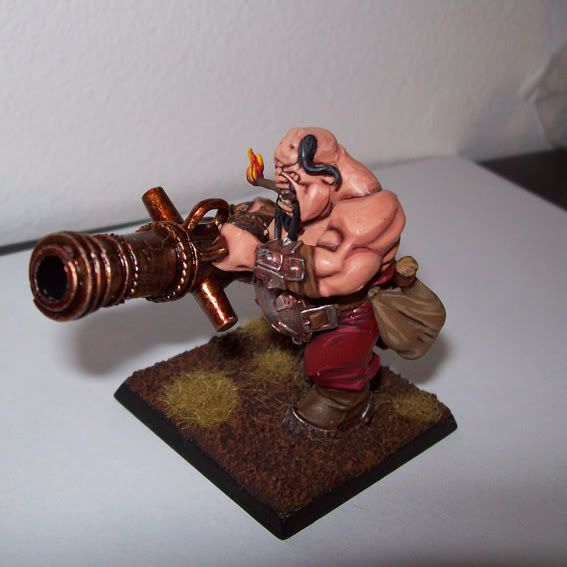
The 2005 army book followed an almost identical format for the unit pages/army list layout, and continued the general strategy of refining existing units/mechanics (except crossbowmen are now "quarrelers" and stone throwers are "grudge throwers" hurtling fragments of fallen Dwarf holds engraved with literal grudges) and adding new options. From a game mechanic standpoint, the most important addition was the Oathstone.
 The green stuff is known as "green stuff," it's a kind of light modeling putty that you get by mixing together yellow and blue putties, forming a very malleable substance that dries to the consistency of wood. You can form it into quite elaborate shapes, as shown, and after it dries it can be carved; it also takes paint well.
The green stuff is known as "green stuff," it's a kind of light modeling putty that you get by mixing together yellow and blue putties, forming a very malleable substance that dries to the consistency of wood. You can form it into quite elaborate shapes, as shown, and after it dries it can be carved; it also takes paint well.
Oathstones let "stonebearer" characters and attached units (Warriors, Longbeards, Ironbreakers, or Hammerers) to set the stone down and "hold," which makes the dwarfs into a little castle, pretty much. And you thought the gritsuckers were hard to shift
before...
(Honestly, I think it was mostly about the new Hold rules, which I personally never gave a crap about because they also made Pike formations invincible in 7th edition.)
The Anvil of Doom got yet another re-write with this edition. This time, you pick one of three runes the Anvil can be equipped with (Rune of Hearth & Hold, Rune of Oath & Honour, Rune of Wrath & Ruin) associated with a particular Dwarf Ancestor god (Valaya, Grungni, and Grimnir respectively). Normally a runesmith can invoke the rune's power on a 2+ on a d6; or 4+ if they decide to go for the "ancient power." Hearth & Hold lets dwarfs re-roll failed Fear and Terror tests (ancient: re-roll Panic and Break tests, units are immune to fear and terror), Oath & Honour lets a unit shoot
and move (ancient: d3 units), Wrath & Ruin sends an earthquake to destroy a unit (ancient power: more dice).
There's also an option in an online add-on for the "Rune of Reflection" which basically gives you the ability to reflect spells, but that's mainly intended for insane epic battles against elves.
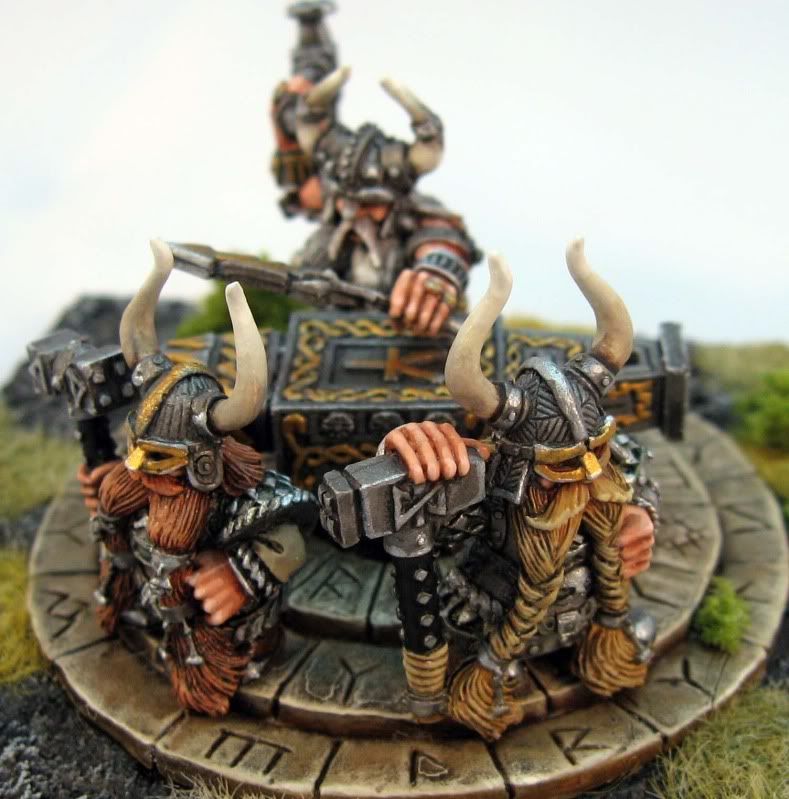
Miners get some nice things: a steam-powered drill so that they don't quite have as much a chance of absolutely missing a battle and small explosives they can throw at the enemy.
On a related note, in addition to Engineers there are now Master Engineers.
 Steam...punk? Is that like an apprentice?
Steam...punk? Is that like an apprentice?
There's a little sidebar here about the Engineer and Master Engineer acting as "additional crew," so I might as well point this out. Back in the grognardy days of Warhammer 4/5th edition, it was not uncommon for the enemy cavalry (or dragon, whatever) to break through to the (mostly static) artillery in the rear, which usually have a crew of three units. Faced with this, the crew would either die (rendering the artillery piece useless) or flee (again rendering it useless, but at least maybe the crew can come back?) Eventually somebody asked if random crew members from one artillery piece could replace missing crew on another - like say one cannon blows up and the survivor staggers over to the next cannon on the line to lend a hand (he's got but one). This caused
a steaming shitpile among rules lawyers, which is why the Engineers have specific rules letting them substitute in for crew members. I love this hobby.
 And not just for the cosplay.
And not just for the cosplay.
Mechanically and organization-wise, the 2000 and 2005 army lists are almost identical; the only major difference is that Longbeards are no longer a standalone special unit, they're an upgrade choice for Dwarf Warriors; there's a bit of point shaving here and there which I'm not sure makes much of a difference - do you really care if your Dwarf Warrior is 8 points instead of 7?
And that, after a very long post, is the Dwarf Throng, the core of the three books. Next up: Special Characters!


